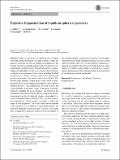Files in this item
Explosive fragmentation of liquids in spherical geometry
Item metadata
| dc.contributor.author | Milne, Alexander Mitchell | |
| dc.contributor.author | Longbottom, Aaron William | |
| dc.contributor.author | Frost, David | |
| dc.contributor.author | Loiseau, Jason | |
| dc.contributor.author | Goroshin, Samuel | |
| dc.contributor.author | Petel, Oren | |
| dc.date.accessioned | 2016-07-12T11:30:09Z | |
| dc.date.available | 2016-07-12T11:30:09Z | |
| dc.date.issued | 2017-05 | |
| dc.identifier | 243472746 | |
| dc.identifier | 5f6c69ef-0b4a-44f1-b2be-f125ca1f9e20 | |
| dc.identifier | 84978116076 | |
| dc.identifier | 000399434700003 | |
| dc.identifier.citation | Milne , A M , Longbottom , A W , Frost , D , Loiseau , J , Goroshin , S & Petel , O 2017 , ' Explosive fragmentation of liquids in spherical geometry ' , Shock Waves , vol. 27 , no. 3 , pp. 383-393 . https://doi.org/10.1007/s00193-016-0671-y | en |
| dc.identifier.issn | 0938-1287 | |
| dc.identifier.uri | https://hdl.handle.net/10023/9116 | |
| dc.description.abstract | Rapid acceleration of a spherical shell of liquid following detonation of a high explosive causes the liquid to form fine jets that are similar in appearance to the particle jets that are formed during explosive dispersal of a packed layer of solid particles. Of particular interest is determining the dependence of the scale of the jet-like structures on the physical parameters of the system, including the fluid properties (e.g., density, viscosity, surface tension) and the ratio of the mass of the liquid to that of the explosive. The present paper presents computational results from a multi-material hydrocode describing the dynamics of the explosive dispersal process. The computations are used to track the overall features of the dispersal of the liquid layer, including the wave dynamics, and motion of the spall and accretion layers. The results are compared with experimental results of spherical charges surrounded by a variety of different fluids, including water, glycerol, ethanol, and vegetable oil, which together encompass a significant range of fluid properties. The results show that the number of jet structures is not sensitive to the fluid properties, but primarily dependent on the mass ratio. Above a certain mass ratio of liquid fill to explosive burster (F/B), the number of jets is approximately constant and consistent with an empirical model based on the maximum thickness of the accretion layer. For small values of F/B, the number of liquid jets is reduced, in contrast with explosive powder dispersal, where small F/B yields a larger number of particle jets. A hypothetical explanation of these features based on nucleation of cavitation is explored numerically. | |
| dc.format.extent | 2403030 | |
| dc.language.iso | eng | |
| dc.relation.ispartof | Shock Waves | en |
| dc.subject | Experiment | en |
| dc.subject | Modelling | en |
| dc.subject | Explosion | en |
| dc.subject | Fragmentation | en |
| dc.subject | QA Mathematics | en |
| dc.subject | QC Physics | en |
| dc.subject | NDAS | en |
| dc.subject.lcc | QA | en |
| dc.subject.lcc | QC | en |
| dc.title | Explosive fragmentation of liquids in spherical geometry | en |
| dc.type | Journal article | en |
| dc.contributor.institution | University of St Andrews. Applied Mathematics | en |
| dc.identifier.doi | 10.1007/s00193-016-0671-y | |
| dc.description.status | Peer reviewed | en |
This item appears in the following Collection(s)
Items in the St Andrews Research Repository are protected by copyright, with all rights reserved, unless otherwise indicated.

